Effective Techniques for Cleaning a Clogged Kitchen Sink Drain
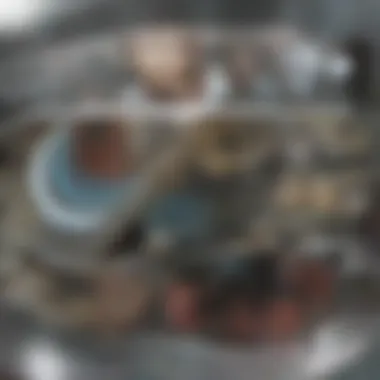

Intro
A clogged kitchen sink drain poses a significant inconvenience in any household. Understanding the causes and solutions can save homeowners both time and potential expenses. This article provides measured techniques for addressing such clogs effectively, covering everything from common causes to preventative measures and DIY fixes.
By grasping the underlying mechanics of kitchen sink drainage systems, one can not only resolve existing issues but also implement strategies to minimize future occurrences.
The Importance of Drain Maintenance
Regular maintenance is essential for keeping kitchen drains flowing smoothly. Simple practices, such as avoiding disposal of grease and food particles, can make a significant difference. Let’s explore effective techniques for keeping these inconveniences at bay.
Understanding the Kitchen Sink Drain System
Understanding the kitchen sink drain system is crucial for homeowners who want to effectively address and prevent clogs. A solid comprehension of how this system operates can lead to better maintenance practices and faster resolutions to problems when they arise. Knowing the components involved, as well as their functions, allows for more informed decision-making regarding cleaning and repairs.
This section will delve into the main parts of the drainage system, explaining their roles and the overall process of drainage. By grasping the mechanics behind this system, homeowners can significantly enhance their ability to manage kitchen sink blockages.
Components of the Drainage System
The kitchen sink drainage system consists of several key components:
- Sink Basin: This is where water collects. Food particles, grease, and other materials often accumulate here.
- P-Trap: This curved pipe section holds a small amount of water, creating a seal to prevent sewer gases from entering the kitchen. Additionally, it can trap debris that contributes to a blockage.
- Drainpipe: This component transports wastewater from the sink to the home’s sewer system. It includes various angles for effective drainage.
- Vent Pipes: These vertical pipes allow air to enter the drainage system, helping to maintain pressure and promoting smooth water flow. Without sufficient ventilation, drainage can become slow, leading to clogs.
Each of these elements must function properly to ensure the system operates efficiently. Understanding them is the first step in preventing and addressing any issues that may arise.
How Drainage Works
The drainage system relies on gravity to move waste and water away from the kitchen sink. When you run the faucet, water flows into the sink basin, carrying with it any debris.
Once it reaches the drain, the water exits through the P-trap and into the drainpipe. Here, gravity does its work, directing the flow toward the sewer system. However, for this process to function effectively, the entire system must be clear of blockages.
Factors like food waste, grease, and foreign objects can easily impede this flow. If clogs develop in any of the components, it can slow down or halt drainage completely.
Additionally, ventilation plays a vital role; if the air pressure is not balanced, it can result in siphoning and poor drainage. Therefore, knowledge of how drainage works helps in both diagnosing issues and implementing effective cleaning techniques.
Common Causes of Clogged Kitchen Sink Drains
Understanding the common causes of clogs in kitchen sink drains is fundamental for effective plumbing maintenance. Identifying these culprits not only helps in resolving current issues but also aids in preventing future problems. Most homeowners can manage minor clogs if they are equipped with the right knowledge. Being aware of what typically leads to these blockages enables one to make informed decisions about disposal and maintenance practices, ultimately protecting the integrity of the plumbing system.
Food Waste Buildup
Food waste buildup is a prominent issue when it comes to clogged kitchen sinks. When bits of food are rinsed down the drain, they can accumulate over time, particularly in pipes that have narrow passages. This accumulation leads to blockages that disrupt normal drainage. Often, not all food waste breaks down completely, contributing to significant buildup.
To mitigate this issue, implement better disposal habits. Always scrape plates into the trash before rinsing them. If you have a garbage disposal unit, run it regularly to keep food particles from sticking to the drains. Using a strainer can also capture food particles before they enter the plumbing.
Grease Accumulation
Grease accumulation is another leading factor in clogged drains. Common kitchen activities, such as frying or cooking with oils, lead to grease being washed into the sink. When grease cools, it solidifies and adheres to the pipeline walls, creating a layer that progressively narrows the drain passage.
To avoid this, never pour grease down the sink. Allow grease to cool and then dispose of it in a solid waste container. Periodically, hot water coupled with dish soap can help to dissolve some grease buildup. However, continuous preventative measures are essential for maintaining drain function.
Foreign Objects
Foreign objects are often an immediate cause of clogs in kitchen sink drains. Items that accidentally fall into the sink, such as utensils, food wrappers, or small toys, can create blockages. These blockages can be especially problematic as they may cause sudden drainage issues.
To prevent clogs from foreign objects, it is critical to watch what goes near the sink. Installing a drain strainer can catch items that would otherwise slip down the drain. Ensure children understand the importance of keeping non-food items away from the sink area. An active vigilance in the kitchen can significantly reduce the risk of these clogs.
Preventing Clogs Before They Happen
Preventing clogs in your kitchen sink drain is essential for maintaining an efficient and functional kitchen. A clogged sink can disrupt daily routines, create unpleasant odors, and lead to costly plumbing repairs. Understanding how to prevent clogs not only saves time and money but also enhances the longevity of your plumbing system. This section explores effective strategies that can help avoid the common causes of clogged drains, focusing on proper food waste disposal and the importance of regular maintenance.
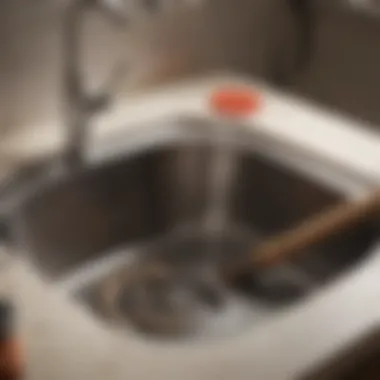
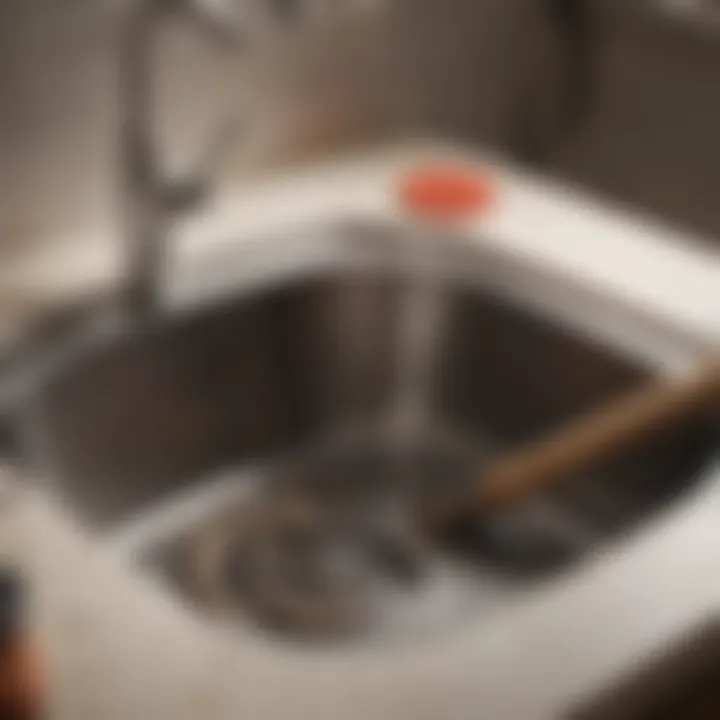
Proper Disposal of Food Waste
Improper disposal of food waste contributes significantly to clogged kitchen sinks. Many people underestimate the impact of what they put down their drains. Food scraps, particularly larger pieces, can accumulate and create obstructions. It’s crucial to utilize proper disposal techniques. Here are several effective practices:
- Use a Waste Disposal Unit: If you have a garbage disposal, use it wisely. It can handle smaller food particles but avoid fibrous vegetables, bones, and hard shells. Always run cold water while using it to help clear out debris.
- Banish Grease: Do not pour cooking oil or grease down the drain. Instead, store it in a container and dispose of it in the trash. Grease hardens when cooled and can quickly form clogs.
- Scrape Plates: Before washing dishes, scrape off leftover food into the trash or compost. This step can vastly reduce the amount of organic matter entering your pipes.
"Effective disposal starts with understanding what should never be put down the drain."
Regular Maintenance Tips
Regular maintenance is essential for keeping your kitchen sink drain in optimal condition. Simple habits can greatly reduce the risk of clogs. Consider these routine maintenance practices:
- Flush with Hot Water: Periodically pouring hot water down the drain can help melt away accumulated grease and food particles. Aim to do this at least once a week.
- Cleaning the Trap: The drain trap can hold waste and food particles. Inspect it regularly and clean it out to prevent buildup.
- Use Vinegar and Baking Soda: A mixture of vinegar and baking soda can help clean the pipes naturally. Pour half a cup of each down the drain, allow it to fizz for about 30 minutes, and then flush with hot water.
- Check Faucets and Hoses: Regularly inspect all plumbing connections. Tighten any loose fittings and replace worn hoses before leaks occur.
By integrating these preventive measures into your routine, you can considerably decrease the incidence of clogged kitchen sinks and maintain a smooth-running kitchen.
Evaluating the Clog Severity
When it comes to addressing clogged kitchen sink drains, understanding the severity of the clog is crucial. This evaluation process determines the effectiveness of various cleaning techniques and helps homeowners make informed decisions. Knowing whether the clog is mild, moderate, or severe can save time and reduce costs associated with potential plumbing services. Immediate recognition of the degree of blockage aids the approach to remediation, narrowing down whether a simple DIY method is sufficient or if professional intervention is necessary.
Identifying Symptoms of a Clog
Recognizing the early signs of a clog can prevent more complex issues later. Homeowners should be attentive to the following symptoms:
- Slow Drainage: If water is not flowing down quickly, it is often the first indicator of a clog.
- Unpleasant Odors: Bad smells emanating from the sink may point to decaying organic material caught in the drain.
- Gurgling Sounds: Noise when water drains is a clear sign that air is trapped in the plumbing system.
- Backflow Issues: Water pushing back up into the sink indicates a serious problem that requires immediate attention.
Being aware of these symptoms allows for a quicker response, potentially avoiding the need for costly repairs.
Deciding on DIY vs. Professional Help
Once a homeowner has evaluated the severity of the clog and identified the symptoms, they must determine whether to tackle the problem themselves or call in a professional plumber. Here are key considerations for making this decision:
- Severity of Clog: For minor clogs, simple methods like using a plunger or baking soda and vinegar mixture can be sufficient. For significant blockages, advanced tools or professional equipment may be necessary.
- Time and Resources: If you are short on time or lack the tools necessary for effective cleaning, hiring a professional may be the best option.
- Experience Level: Homeowners should honestly assess their skills. If plumbing is not an area of expertise, a mistake could lead to further damage.
- Cost Factors: Evaluate the cost comparison between purchasing cleaning supplies for DIY methods and hiring a plumber. Always consider long-term implications of choosing one over the other.
Do-It-Yourself Cleaning Techniques
Do-it-yourself cleaning techniques provide a practical and often cost-effective way to address clogged kitchen sink drains. These approaches empower homeowners to tackle clogs with minimal investment in materials and time. Understanding these techniques can also enhance one's capability to maintain a functional kitchen, preventing future obstructions from occurring.
Using a Plunger
A plunger is one of the simplest and most effective tools for clearing a clogged kitchen sink. It works by creating pressure that can dislodge blockages. To effectively use a plunger:
- Prepare the Area: Remove any standing water. If the sink is too full, you may need to scoop some out.
- Position the Plunger: Place the plunger over the drain, ensuring it covers the opening completely.
- Create a Seal: Ensure a tight seal around the drain with the plunger.
- Pump: Push down forcefully and pull up quickly. Repeat this motion several times.
- Check the Drain: After a few pumps, check if the water begins to drain. If it does, the clog may be cleared.
This method is especially useful for minor clogs caused by food waste or grease. A quality plunger will greatly enhance the likelihood of success.
Vinegar and Baking Soda Method
The combination of vinegar and baking soda is a popular home remedy for cleaning drains. This method utilizes a chemical reaction that can break down clog-producing materials. Here's how to execute it:
- Add Baking Soda: Pour about half a cup of baking soda directly into the drain.
- Pour Vinegar: Follow with half a cup of vinegar. The two substances will create a bubbling reaction, which helps to loosen debris.
- Let it Sit: Allow the mixture to work for at least 30 minutes. For tougher clogs, leaving it for a few hours can be beneficial.
- Flush with Hot Water: After the waiting period, flush the drain with hot water to clear out any remaining debris.
This method is also environmentally friendly, as it avoids harsh chemicals, making it a good option for households concerned about using safe substances.
Manual Inspection and Cleaning
In some situations, clogs may not respond to simpler methods. When that occurs, manual inspection and cleaning may be necessary:
- Remove the Stopper: Start by taking out the sink's stopper. This may require some unscrewing.
- Inspect the Drain: Use a flashlight to look into the drain for visible blockages.
- Use a Hook or Wire: Bend a coat hanger into a hook shape and use it to extract any clog materials you can see.
- Clean the P-trap: If the clog persists, you may need to remove the P-trap underneath the sink for a thorough cleaning. Be prepared for small spills of water.
- Reassemble the Components: After clearing, reassemble the components and ensure everything fits snugly.


Manual inspection gives a comprehensive view of the clog condition and allows for a direct response to the issue. These techniques, when performed correctly, can be effective in maintaining kitchen sink functionality for years.
Chemical Drain Cleaners
Chemical drain cleaners are a popular solution for addressing clogged kitchen sink drains. They are designed to dissolve debris and obstructions with powerful chemical reactions. Homeowners often lean towards these products due to their convenience and apparent effectiveness. However, the use of such cleaners comes with both benefits and potential risks that must be considered prior to application.
Effectiveness and Considerations
The effectiveness of chemical drain cleaners varies depending on the type of product used. Many are formulated with strong substances like sodium hydroxide or sulfuric acid, which can break down organic matter effectively. This makes them suitable for clogs caused by food waste or grease.
However, not all clogs can be effectively treated with chemical solutions. Hard objects, such as toys or utensils, are beyond the dissolving capabilities of these products. Additionally, frequent reliance on chemical cleaners can lead to pipe damage over time. They can corrode plumbing fixtures if used excessively or improperly.
"Use chemical drain cleaners sparingly and only when necessary to prevent long-term plumbing issues."
In addition to strength, it’s crucial to consider the specific conditions of your plumbing system. Older pipes may be more susceptible to damage, making the use of harsher chemicals even more risky. Moreover, these products often come with warnings about the potential for fumes that can be harmful to inhalation. Therefore, evaluating the severity of the clog and identifying the appropriate method for removal is key.
Safety Precautions
When using chemical drain cleaners, safety precautions should always be a priority. First, ensure the area is well-ventilated. Fumes from these products can be irritating, and proper airflow can help mitigate potential hazards.
Secondly, always wear protective gear. This includes gloves and goggles to prevent skin and eye irritation, as the chemicals can cause burns upon contact. If the instructions recommend dilution, follow them closely to avoid dangerous chemical reactions.
It is also important to avoid mixing different types of chemical cleaners. Combining products can lead to dangerous chemical reactions that produce toxic gases. Always store these cleaners out of reach of children and pets to prevent accidental ingestion.
Lastly, never pour chemical drain cleaners down a drain that has no water flow. If standing water is present, the chemicals may linger and concentrate, increasing the risk of damage to your pipes.
Advanced Tools for Clog Removal
When dealing with clogged kitchen sink drains, using advanced tools can significantly enhance the effectiveness of your cleaning efforts. These tools offer specialized solutions that specifically target stubborn clogs, making it easier to restore drainage functionality. Understanding the different types of tools available, as well as their benefits and limitations, is crucial for homeowners looking to maintain a clog-free kitchen sink.
Using a Drain Snake
A drain snake, also known as a plumbing auger, is an effective tool for removing clogs that are not easily resolved with traditional methods. This long, flexible device can navigate through the bends of your plumbing system, reaching deep into the pipes where blockages may reside. The snake works by drilling through the clog or grabbing hold of the obstruction, allowing you to pull it back out.
Benefits of Using a Drain Snake:
- Deep Reach: Its flexible design allows it to navigate tight turns within the plumbing, reaching areas that a plunger cannot.
- Reusable: Unlike chemical drain cleaners or some manual methods, a drain snake can be used multiple times, making it a cost-effective choice.
- Environmentally Friendly: Since it requires no harsh chemicals, using a drain snake minimizes environmental impact and the risk of damaging the pipes.
Considerations:
- Skill Required: Using a drain snake can require some skill, especially for deeper blockages. A lack of experience may result in damage to the pipes.
- Not Always Effective: While effective for many types of clogs, a drain snake may not be successful with certain blockages, such as those caused by heavy grease or extensive build-up.
Hydro Jetting
Hydro jetting involves the use of high-pressure water jets to clean blockages in pipes. This method is particularly effective for extensive build-up and can remove both clogs and residue that could lead to future issues. The technology uses specialized equipment that shoots water at high pressure, effectively clearing out debris and scaling.
Benefits of Hydro Jetting:
- Thorough Cleaning: It not only clears the clog but also cleans the pipe walls, reducing the chance of future blockages.
- Efficiency: This method is quick and can handle a variety of clog types, including grease and mineral deposits.
- Non-Invasive: Hydro jetting is a less invasive solution compared to traditional pipe snake methods, offering an efficient way to maintain pipe integrity.
Considerations:
- Cost: Hydro jetting can be more costly than other techniques, especially if specialized equipment is required.
- Professional Assistance: This technique usually requires a professional plumber due to the need for specialized equipment and expertise.
Hydro jetting represents a powerful solution for situations where other methods fail, but it is best utilized as a part of regular maintenance or when significant build-up is detected.
Both the drain snake and hydro jetting provide advanced options for handling kitchen sink clogs. Choosing the right tool or method often depends on the nature of the blockage you are dealing with, as well as your own comfort level with performing plumbing tasks.
When to Call a Professional Plumber
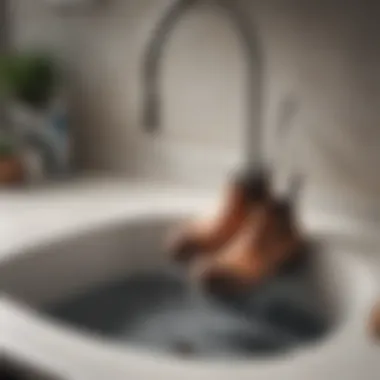
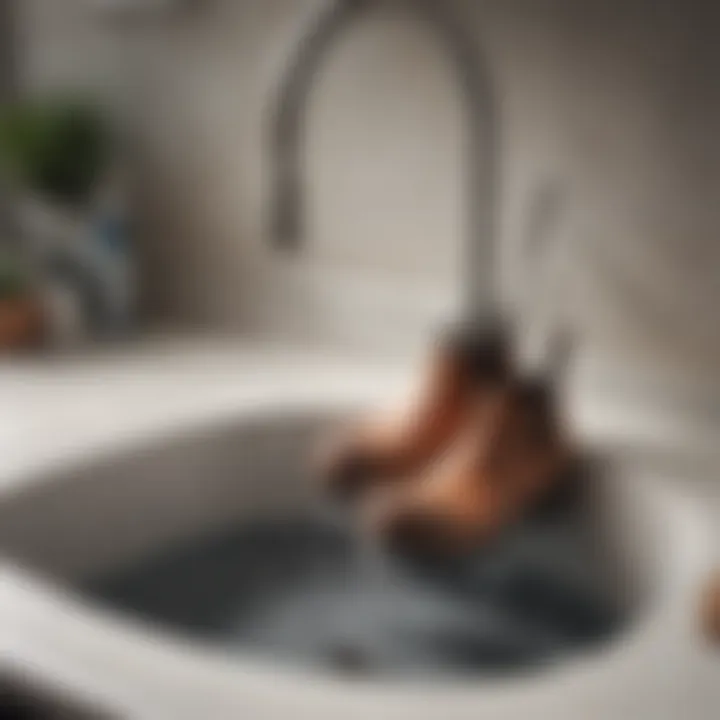
Clogged kitchen sink drains can lead to frustrations and mess. Understanding when to call a professional plumber is crucial. While many clogs can be handled with DIY techniques, some situations require expert intervention. Recognizing the signs of serious issues and knowing when it is time to seek professional help can save you from further damage and costly repairs.
Signs You Need Professional Help
Several indicators suggest that it's best to involve a plumber. Common signs include:
- Persistent Clogs: If simple methods like plungers or vinegar and baking soda fail repeatedly, this indicates a deeper issue.
- Multiple Drains Blocked: When more than one drain is slow or clogged, the problem may not be isolated to your kitchen sink.
- Unpleasant Odors: Foul smells coming from your sink may suggest a severe blockage or even a sewage problem.
- Gurgling Noises: If you hear gurgling sounds when draining water, this could signal an obstruction in the drainage system.
- Water Backing Up: If dirty water starts to back up, it may compromise the plumbing system.
Ignoring these signs can lead to greater plumbing issues, including potential water damage.
Understanding Plumbing Costs
When it comes to hiring a professional plumber, it’s essential to understand the costs involved. Various factors influence pricing, including:
- Location: Prices can vary greatly depending on your area.
- Nature of the Problem: Simple tasks, like clearing a drain, typically cost less compared to major issues needing extensive repair.
- Hourly Rate: Many plumbers charge by the hour. This could range from $50 to $150 or more, depending on experience and location.
In addition to these rates, homeowners should also account for possible additional costs, such as:
- Materials: Sometimes, new fittings or materials are needed.
- Emergency Services: Call-outs during non-business hours often come with higher fees.
Understanding these aspects can prepare the homeowner for any unexpected costs. Regular maintenance checks and timely professional help can mitigate extensive future expenses.
Maintaining a Clog-Free Kitchen Sink
Maintaining a clog-free kitchen sink is essential for the smooth functioning of every home. A blocked sink can disrupt daily tasks, cause unpleasant odors, and even lead to costly plumbing repairs. Understanding the importance of regular maintenance is key to preventing clogs from forming.
A kitchen sink that drains properly enhances overall kitchen hygiene. Food particles, grease, and other debris can accumulate, making it easy for clogs to develop if not managed. Recognizing this, homeowners must adopt a systematic approach to maintenance. This approach ensures that minor issues are addressed before they escalate into major problems.
Establishing a Cleaning Routine
Creating a consistent cleaning routine is one of the most efficient ways to prevent clogs. This routine should include:
- Daily Rinsing: After washing dishes, rinse the sink with hot water to flush out small particles and grease.
- Weekly Cleaning: Use a mixture of vinegar and hot water at least once a week to clear any buildup in the drain. Pour one cup of vinegar down the drain, followed by two cups of boiling water.
- Monthly Inspections: Check for signs of slow drainage or unusual odors. Early detection can save substantial time and effort in the future.
By establishing these simple habits, homeowners can keep their kitchen sinks functioning effectively and minimize the risk of clogs.
Long-Term Preventive Practices
Long-term preventive practices enhance the effectiveness of cleaning routines. These practices can include:
- Install a Drain Screen: A simple drain screen catches food particles and foreign objects, preventing them from entering the plumbing.
- Avoid Pouring Grease Down the Sink: Instead, let grease cool and dispose of it in the trash. This practice drastically reduces the likelihood of grease buildup.
- Educate Household Members: Make sure everyone understands what should and should not be placed down the sink. This awareness can prevent foreign objects from causing clogs.
"Regular maintenance is not just about cleaning; it’s about creating awareness and adopting wise habits to prevent issues from arising."
End
Cleaning a clogged kitchen sink drain is a vital aspect of maintaining a functional and hygienic kitchen. This article outlines numerous effective techniques that can provide homeowners with the knowledge and tools necessary to manage clogs efficiently. Understanding the composition of the kitchen drainage system and recognizing common causes like food buildup or grease accumulation are critical in determining the most suitable cleaning method.
It is essential to emphasize that a proactive approach to managing kitchen drains can save time, money, and unnecessary frustration. The provided techniques range from simple DIY methods to advanced interventions, ensuring that any clog scenario can be addressed adequately. Homeowners should also weigh the benefits of regular inspection and maintenance alongside the need for immediate solutions when clogs do occur.
All in all, knowing how to effectively clear blocked drains not only restores the usual flow of water but also contributes to a cleaner, healthier kitchen environment., enhancing one's overall living experience.
Summary of Key Points
- The kitchen sink drain system consists of various components that facilitate waste disposal and drainage.
- Common causes of clogs include food waste buildup, grease accumulation, and foreign objects.
- Preventive strategies, such as proper waste disposal and consistent maintenance, can mitigate clogging issues.
- Assessing clog severity helps in deciding whether DIY cleaning methods or professional assistance is necessary.
- Multiple effective techniques exist, including plunging, using vinegar and baking soda, and manual cleaning.
- Chemical drain cleaners are available but should be used with caution due to potential safety hazards.
- Advanced tools like drain snakes and hydro jetting can provide further assistance in severe cases.
- Recognizing signs that necessitate professional plumber intervention ensures timely resolution and prevents further damage.
- Establishing a regular cleaning routine and long-term maintenance practices can keep the kitchen sink drain in optimal condition.
Importance of Regular Maintenance
Regular maintenance of the kitchen sink drain is crucial for preventing clogs. This process involves forming habits that include:*
- Promptly disposing of food waste using appropriate garbage disposal methods,
- Utilizing strainers to catch debris,
- Flushing the drain with hot water periodically to dissolve any buildup,
- Scheduling periodic inspections of the plumbing system for wear and tear.
By integrating these practices into daily routines, homeowners can significantly extend the life of their drainage systems. A well-maintained kitchen sink not only functions better but also reduces the risk of more severe plumbing problems. Moreover, being proactive can decrease the chances of hefty plumbing costs associated with major clogs or damage.
In summary, committing to regular maintenance fosters an efficient kitchen environment, ultimately enhancing the overall domestic experience.







